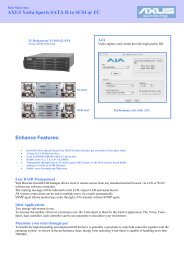WHITE PAPER Business Continuity: More than Just Waiting for ...
WHITE PAPER Business Continuity: More than Just Waiting for ...
WHITE PAPER Business Continuity: More than Just Waiting for ...
You also want an ePaper? Increase the reach of your titles
YUMPU automatically turns print PDFs into web optimized ePapers that Google loves.
HISTORICAL DATA RECOVERY AND PROTECTION OPTIONS<br />
In the past, concerns about business continuity centered on data replication <strong>for</strong> critical<br />
in<strong>for</strong>mation systems including online transaction processing (OLTP) and other largescale<br />
business applications deployed by large enterprises and hosted in one or more<br />
datacenters. IT managers backed up databases, files, or data sets after business<br />
hours and moved copies to remote storage archives via shipment of removable media<br />
(e.g., magnetic tape or optical disks). For the most critical in<strong>for</strong>mation in transactionintensive<br />
applications, IT managers also had the option of replicating (mirroring) data<br />
to disaster recovery sites via very expensive high-speed network links.<br />
Tape backup is the oldest and most widely deployed data recovery and data<br />
protection solution. As a removable medium, tape is easy to transport, making it easy<br />
to protect data by moving it out of harm's way. The limitations of tape backup include<br />
the following:<br />
! Extended periods where important data (e.g., changes made in the past 24<br />
hours) is not protected until the next backup cycle<br />
! Slow recovery times (tapes must be physically transported to and from remote<br />
sites) that can range from half a day to more <strong>than</strong> two days<br />
! Risk of damage to tape media that prevents recovering data<br />
! Inconsistent ability to recover due to uncertainties in the quality of specific<br />
backups (the severity of this uncertainty varies widely from high-end mainframe<br />
systems that are very reliable to more dispersed solutions <strong>for</strong> open systems,<br />
where failure rates can approach 50%)<br />
In today's increasingly complex IT environment, where multiple applications and data<br />
sets are interdependent, data synchronization creates a new challenge <strong>for</strong> tapebased<br />
disaster recovery strategies. IT managers must be able to create simultaneous<br />
point-in-time copies <strong>for</strong> multiple data sets, thereby creating I/O-consistent copies.<br />
The advent of disk-to-disk data mirroring to a remote disaster recovery site<br />
overcame many of the shortcomings of tape through improved protection of recently<br />
created data as well as faster and more reliable application recovery. The<br />
deployment of such solutions, however, was often very expensive due to the<br />
replication of facilities and extremely high telecommunications costs (often 50–70%<br />
of ongoing costs). As a consequence, companies protected only the most missioncritical<br />
applications with this type of solution, leaving the vast majority of data and<br />
applications dependent on tape.<br />
IMPROVING BUSINESS CONTINUITY OPTIONS<br />
These limited data replication options don't mesh well with IT managers' current<br />
business continuity requirements (i.e., accommodating a wide variety of application<br />
and data types with different application recovery and data protection thresholds).<br />
Today's BCP must focus on three challenges:<br />
! Decrease the likelihood that IT systems will fail<br />
! Accelerate recovery when IT systems do fail<br />
! Accommodate the on-demand provisioning of processing and storage resources<br />
to compensate <strong>for</strong> greater volatility in IT requirements<br />
4 #3829 ©2003 IDC







